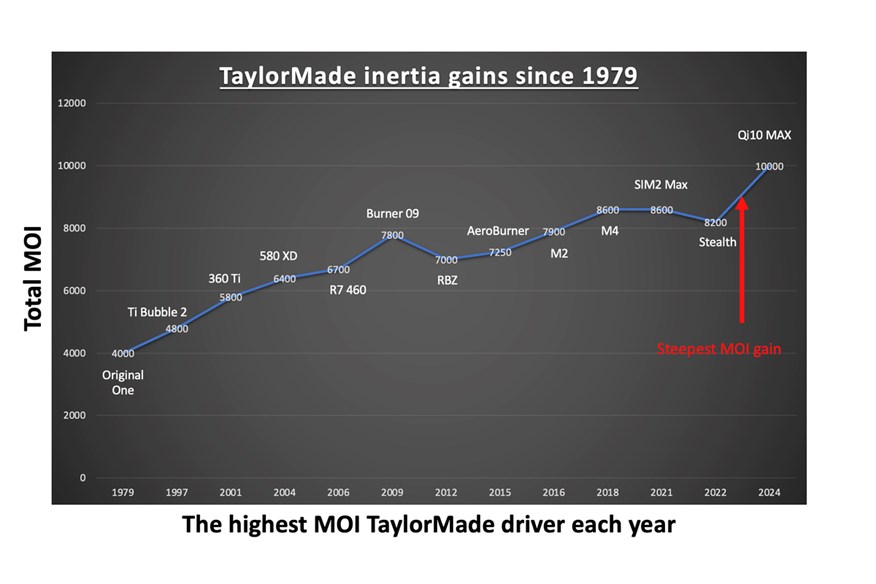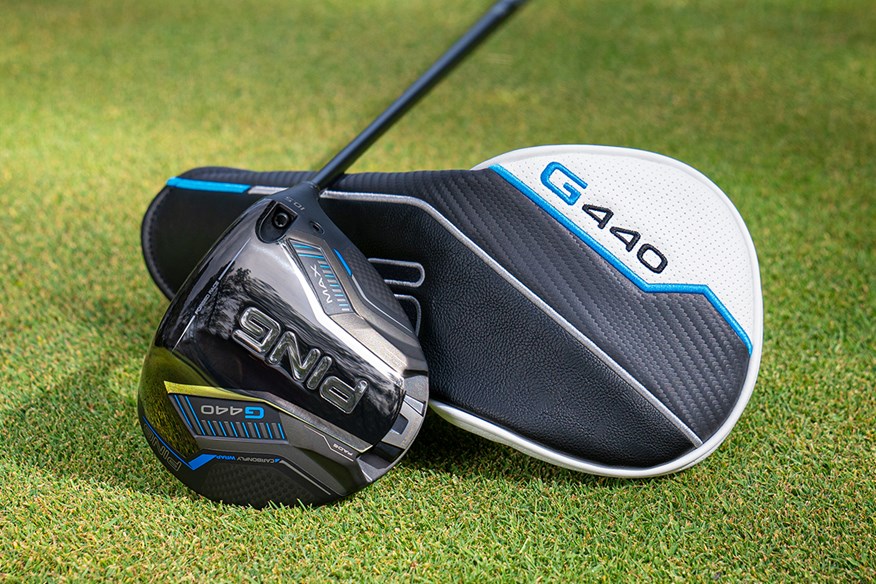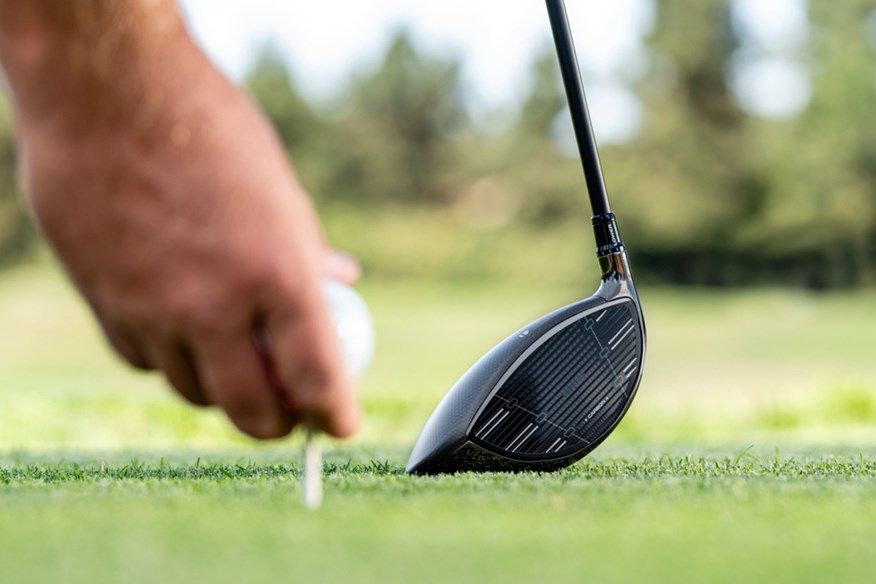The big problem with forgiving drivers – and why a 10K MOI driver might do you more harm than good
Last updated:

High MOI drivers promise straighter shots, but are they the right fit for your game?
In recent years, high MOI (Moment of Inertia) drivers have been hailed as the ultimate in forgiveness, making their way into the bags of everyone from beginners to top professionals.
But while a high MOI driver promises more stability and straighter shots, it might not be the right choice for everyone. Let’s dive into the pros and cons to help you decide if a 10K MOI driver is your perfect match or a potential hindrance.

What is a high MOI driver?
MOI stands for ‘Moment of Inertia,’ which measures an object’s resistance to changes in its rotational motion. In golf, that means how much the clubhead resists twisting when the ball is struck off-center.
- Higher MOI: The clubhead resists twisting, staying more aligned to the target at impact. This results in straighter flight and less loss of speed on mishits.
- Lower MOI: The clubhead twists more easily, potentially leading to shots going more offline and or/ reduced distance.
MOI is measured in grams per centimeter squared. The higher the number, the more the clubhead will resist twisting at impact.
The benefits are clear, which is why brands have pursued higher MOI in recent years and marketed driver models that have MOI above 10,000 g/cm².

Which drivers have the highest MOI?
The TaylorMade Qi35 Max, Ping G440, and Cobra DS-ADAPT Max K are some of the highest MOI drivers on the market, all boasting MOI values of 10,000 g/cm² or more.
The TaylorMade Qi35, Titleist GT1, Srixon ZXi Max, Callaway Elyte, Wilson DynaPower Max, and Mizuno ST-Max all also boast high MOI.

So what’s the problem with high MOI?
Given everything we’ve discussed so far, you might think that the higher the MOI, the better. And for some golfers that will be true. But high MOI drivers aren’t for everyone, and may actually do some people more harm than good.
Here are some potential downsides of high MOI drivers you need to be aware of:
Slower ball speeds and shorter distances
Whilst a higher MOI can help maintain ball speeds and distance on off-center strikes, high MOI drivers don’t tend to be the fastest or longest when it comes to well-struck drives.
To increase MOI, weight is placed further back in the clubhead, which makes it more stable. This increases forgiveness, but having more weight further forward increases the potential maximum for ball speed and therefore distance.
In the recent Today’s Golfer drivers test, we tested every model in its weight forward and weight back setting (those that can be adjusted in that way), and the weight forward setting delivered faster ball speed and longer distance across the board.
| Make | Model | Club Speed (mph) | Ball Speed (mph) | Carry Distance (yds) | Spin Rate (rpm) | Launch Angle (°) | Peak Height (yds) | Descent Angle (°) | L-R Dispersion (yds) |
|---|---|---|---|---|---|---|---|---|---|
| TaylorMade | Qi35 LS (forward) | 119.1 | 167.0 | 298.0 | 2266 | 13.0 | 38.2 | 40.0 | 23.3 |
| Titleist | GT3 | 117.3 | 165.7 | 292.8 | 2378 | 13.0 | 38.9 | 41.6 | 25.2 |
| Titleist | GT4 (forward) | 116.6 | 165.1 | 292.4 | 2274 | 12.9 | 37.1 | 39.9 | 33.3 |
| Callaway | Elyte Triple Diamond (forward) | 116.5 | 165.0 | 290.8 | 2202 | 11.6 | 32.3 | 36.9 | 33.7 |
| Wilson | Dynapwr Carbon (forward) | 117.0 | 165.2 | 289.9 | 2442 | 12.8 | 38.1 | 42.0 | 44.3 |
| Ping | G440 LST | 115.6 | 164.7 | 289.8 | 2502 | 13.7 | 41.6 | 43.8 | 17.7 |
| Srixon | ZXi LS (forward) | 117.6 | 164.4 | 289.4 | 2365 | 12.7 | 37.2 | 41.7 | 46.8 |
| Cobra | DarkSpeed LS (forward) | 117.9 | 164.4 | 287.1 | 2504 | 13.3 | 39.9 | 42.7 | 34.8 |
| PXG | Black Ops Tour (back) | 114.8 | 162.9 | 286.4 | 2126 | 12.6 | 33.1 | 38.4 | 45.6 |
| Wilson | Dynapwr LS (forward) | 114.6 | 162.2 | 286.4 | 2228 | 12.8 | 35.1 | 39.6 | 13.6 |
| PXG | Black Ops Tour (forward) | 112.5 | 164.5 | 286.2 | 2204 | 11.2 | 30.4 | 36.8 | 25.4 |
| Callaway | Elyte Triple Diamond (back) | 116.1 | 164.2 | 286.2 | 2516 | 12.8 | 38.3 | 41.7 | 25.7 |
| Wilson | Dynapwr Carbon (back) | 115.6 | 165.3 | 284.8 | 2682 | 11.7 | 37.4 | 42.3 | 16.1 |
| TaylorMade | Qi35 LS (back) | 117.4 | 165.6 | 284.6 | 2715 | 11.9 | 37.6 | 42.0 | 39.0 |
| Cobra | DarkSpeed LS (back) | 117.4 | 165.2 | 284.2 | 2778 | 12.3 | 39.8 | 43.3 | 32.1 |
| TaylorMade | Qi35 Core (forward) | 116.1 | 163.0 | 283.7 | 2284 | 11.8 | 32.5 | 37.7 | 27.0 |
| Callaway | Elyte Core | 117.3 | 165.3 | 283.3 | 2692 | 11.4 | 35.7 | 40.8 | 26.1 |
| Srixon | ZXi LS (back) | 116.4 | 161.8 | 282.6 | 2337 | 11.8 | 33.3 | 39.4 | 33.0 |
| Callaway | Elyte X | 116.0 | 163.9 | 282.2 | 2585 | 11.9 | 35.4 | 40.5 | 26.7 |
| Wilson | Dynapwr LS (back) | 114.6 | 161.6 | 282.1 | 2408 | 12.9 | 36.8 | 41.4 | 15.9 |
| Ping | G440 Max | 115.1 | 163.1 | 281.8 | 2702 | 12.9 | 39.9 | 43.7 | 31.9 |
| Mizuno | ST-Max | 115.1 | 162.4 | 281.7 | 2519 | 12.8 | 37.3 | 42.1 | 32.3 |
| Cobra | DarkSpeed X (forward) | 116.2 | 161.1 | 281.4 | 2443 | 12.9 | 37.1 | 42.1 | 36.7 |
| Titleist | GT2 | 115.5 | 163.1 | 280.4 | 2728 | 12.1 | 37.9 | 41.9 | 26.2 |
| PXG | Black Ops (forward) | 113.7 | 163.1 | 280.1 | 2610 | 11.2 | 34.0 | 40.3 | 25.6 |
| PXG | Black Ops (back) | 113.2 | 162.5 | 278.0 | 2696 | 12.0 | 36.7 | 42.1 | 41.9 |
| Cleveland | HiBore XL | 113.6 | 160.3 | 277.9 | 2561 | 12.5 | 36.7 | 41.9 | 24.7 |
| Titleist | GT4 (back) | 117.2 | 163.1 | 277.7 | 2876 | 12.8 | 39.7 | 43.5 | 50.9 |
| Cobra | DarkSpeed X (back) | 116.7 | 161.4 | 276.8 | 2777 | 12.9 | 39.6 | 44.0 | 21.5 |
| Cobra | Max D | 117.7 | 163.3 | 276.1 | 2963 | 13.0 | 42.1 | 45.3 | 29.2 |
| Cobra | Max K | 114.6 | 160.6 | 276.1 | 2646 | 12.2 | 36.0 | 41.8 | 33.5 |
| TaylorMade | Qi35 Core (back) | 115.9 | 162.4 | 275.8 | 2856 | 11.7 | 36.7 | 41.9 | 17.9 |
| Srixon | ZXi Core | 115.3 | 161.1 | 275.4 | 2822 | 13.4 | 40.9 | 45.0 | 48.4 |
| TaylorMade | Qi35 Max | 115.8 | 162.3 | 275.4 | 2825 | 11.4 | 35.7 | 41.3 | 16.7 |
| Ping | G440 SFT | 115.9 | 161.8 | 275.3 | 2859 | 13.7 | 41.9 | 46.8 | 42.5 |
| Wilson | Dynapwr Max | 113.9 | 161.5 | 273.2 | 2887 | 12.6 | 38.8 | 44.0 | 18.7 |
| Average | 116.0 | 163.5 | 283.3 | 2554 | 12.4 | 37.1 | 41.6 | 31.4 |
High spin and launch
High MOI drivers don’t just move the weight further back in the head; they also lower it. This increases launch and spin, which can be great for golfers who struggle to generate enough height on their drives but may be detrimental for players who hit it too high and/or generate too much spin. Such golfers may be better off with a low-spin driver.
Visual appeal and confidence
High MOI drivers tend to have larger heads, which can be off-putting for some golfers. While a bigger head can inspire confidence for high handicappers, better players often prefer a smaller, more traditional shape. Smaller heads may also produce less drag, increasing clubhead speed.

Alternatives to high MOI drivers
If you’re unsure about going all-in on a 10K MOI driver, consider these alternatives:
- Low-spin drivers: Often a good option for high swing speeds, reducing spin for optimal distance.
- Adjustable drivers: Many models offer movable weights, allowing you to fine-tune MOI and weight distribution.
- Draw-biased drivers: Ideal for slicers, adding forgiveness and promoting a straighter ball flight.
Who should use a high MOI driver?
Whilst it felt important to highlight the downsides of high MOI drivers for balance in the face of such a strong trend towards them, they do have a lot of benefits and serve many golfers well. If you fit into one of these categories, it’s well worth trying a high MOI driver to see if it works for you:
- You’re buying off-the-rack: If you aren’t getting fitted and making sure that you’re in the best setup, you could look at 10K to make up for the possibly incorrect/imprecise spec you’re buying.
- You’re a beginner golfer: If you’re a new starter and currently finding a swing and equipment that works for you, maximizing forgiveness might be a good idea. It may help you keep your drives in play more often and at this stage you don’t need to worrying about eking out maximum ball speed, carry distances, spin rates, etc.
- You need more height: Many golfers struggle to get enough height on their drives. If that’s you, having the center of gravity as low as possible will help, which tends to be a feature in high MOI drivers.
- You have a high swing speed: Whilst many fast swingers will gravitate towards low-spin drivers, the effect of mishits increases as speeds get higher. If you hold your driver by the shaft so the head is floating and drop a ping pong ball on the toe, it won’t twist at all. If you dropped a heavier object, the head would twist due to the greater force being applied. It’s the same thing when a faster swinger makes impact. Without wishing to get all grade 1 science, Force = Speed x Mass. Faster players apply more force at impact due to their greater speed, and therefore need more stability on mishits to avoid twisting.
- You just want to keep the ball in play: If driving is your weakness and you’re losing too many balls off the tee, a high MOI driver will limit the severity of your misses. Sure, you might give up a little distance on your best strikes, but that can be well worth it, especially when data shows that one extra fairway per round can be worth surrendering 10 yards.

Pros and cons of high MOI drivers
Pros
- Maximum forgiveness: Reduces the impact of off-center hits, keeping more drives in play.
- Straighter shots: Minimizes twisting at impact for more consistent ball flight.
- Higher launch: Ideal for players who struggle to get enough height on their drives.
- Confidence boost: Larger clubhead size can inspire confidence at address.
Cons
- Reduced ball speed: High MOI drivers may sacrifice some distance on well-struck shots.
- Higher spin: Can lead to excess spin for players with naturally high launch conditions.
- Bulky appearance: Some golfers may find the larger head size unappealing.

Conclusion
For years we’ve been sharing the message that choosing the best golf driver isn’t always as simple as picking the longest. But now, in a time of 10K MOI hype, it’s time to add that choosing the most stable isn’t always the right choice.
The right club for your game depends on your swing characteristics, preferences, and goals. While high MOI drivers can be game-changers for those needing forgiveness, golfers prioritizing distance or lower spin might benefit from a lower MOI option.
The best driver is the one that gives you confidence and performance. Test different models, consider your priorities, and find the club that helps you play your best.
READ NEXT: Most forgiving golf drivers
